Peptide Antibiotics Market Size
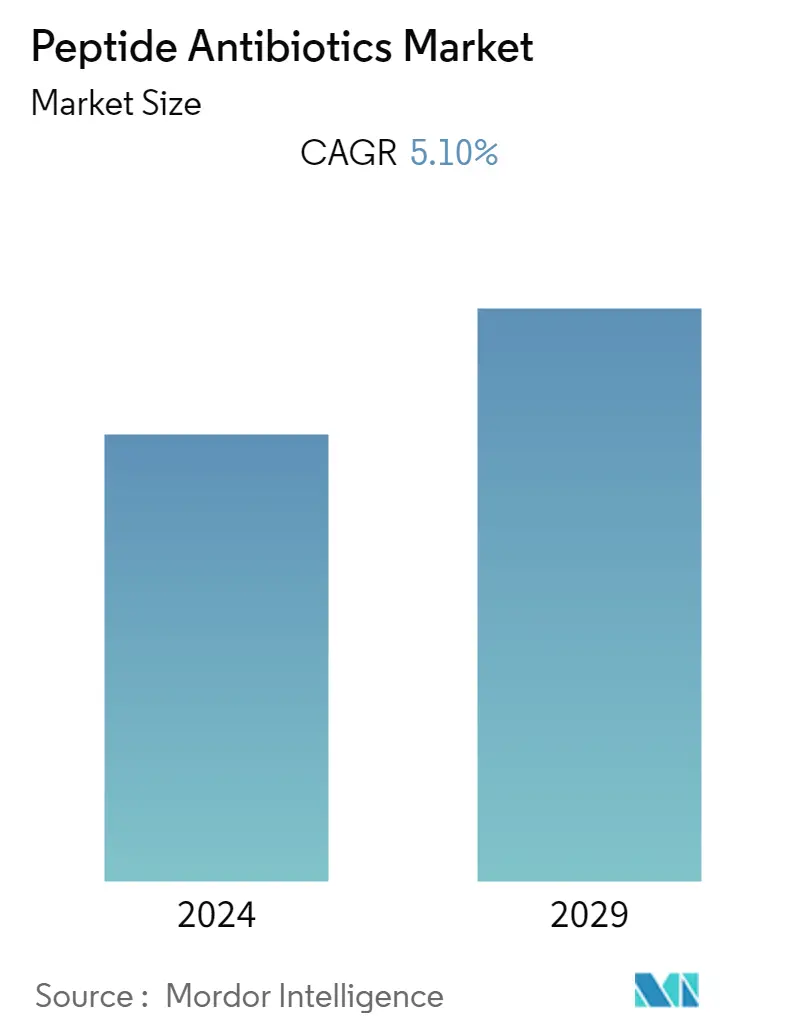
| Study Period | 2019 - 2029 |
| Base Year For Estimation | 2023 |
| CAGR | 5.10 % |
| Fastest Growing Market | Asia-Pacific |
| Largest Market | North America |
| Market Concentration | Medium |
Major Players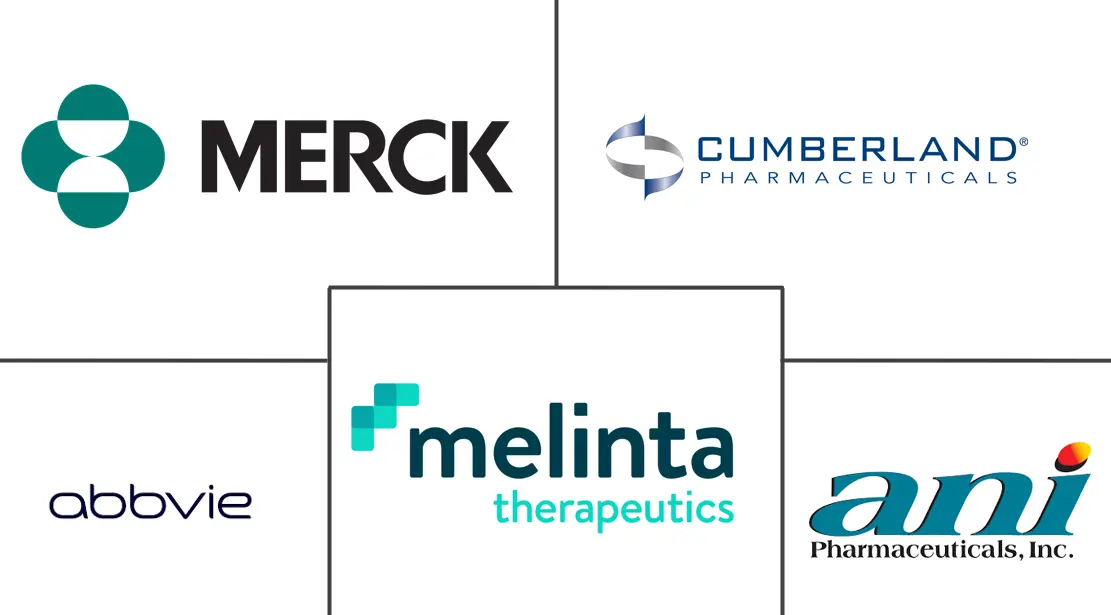
*Disclaimer: Major Players sorted in no particular order |
Peptide Antibiotics Market Analysis
The Peptide Antibiotics Market is anticipated to witness steady growth of 5.1% CAGR over the forecast period.
The COVID-19 pandemic had a substantial impact on the peptide antibiotics market initially. The strict lockdowns and government regulations intended to slow down the spread of COVID-19 resulted in a decrease in the number of patient visits and subsequently hampering the number of prescriptions for peptide antibiotics. Various fungal and bacterial infections remained undiagnosed and untreated due to the strict lockdown. During this period outpatient clinics were closed or operating with limited appointments which resulted in a reduction of in-person visits. The number of antibiotic prescriptions was hampered due to the result of the decline in patient visits. According to a research study published in the Infectious Diseases Society of America in October 2021, the total number of outpatient antibiotic prescriptions decreased by 37.1% during March-December 2020 as compared to the prescriptions provided during March-December 2019.
Moreover, the significant increase in the number of patients suffering from antimicrobial resistance significantly hampered the market growth during the COVID-19 period. According to the report published by the Centers for Disease Control and Prevention, more than 29,400 people died from antimicrobial-resistant infections during the first year of the pandemic (2020). Thus, the COVID-19 outbreak affected the market's growth adversely in its preliminary phase; however, the market is expected to gain traction due to the significant increase in the use of telehealth and telemedicine globally.
Further, the increase in the number of product approvals, surge in the number of patients suffering from various infectious diseases and growing adoption of peptide antibiotics in healthcare settings are among the major factors driving the growth of the studied market. This along with the rising number of patients developing antibiotic resistance is also fueling the utilization of peptide antibiotics. According to the report published by European Centre for Disease Prevention and Control (ECDC) in January 2022, every year more than 670,000 cases of infections due to bacteria resistant to antibiotics are registered in European countries and around 33,000 people deaths occur due the antibiotic resistance.
Moreover, the surge in the prevalence of hospital-acquired infections along with the significant increase in skin and bloodstream infections are anticipated to boost the adoption of peptide antibiotics in the management of infection, thereby contributing to the studied market growth. According to the report published by World Health Organization in 2022, every year 8.9 million healthcare-acquired infections occur in acute and long-term facilities across European countries. Moreover, the side effects associated with the use of peptide antibiotics are anticipated to hamper market growth.
Peptide Antibiotics Market Trends
This section covers the major market trends shaping the Peptide Antibiotics Market according to our research experts:
Non-ribosomal synthesized peptide antibiotics segment is anticipated to Dominate the Market Over the Forecast Period
The non-ribosomal synthesized peptide antibiotics segment is anticipated to hold the largest share of the peptide antibiotics market. The increasing utilization of non-ribosomal synthesized peptide antibiotics such as Gramicidin, Bacitracin, Polymyxin, and Crab tachyplesin in the management of bacterial infections is supporting segment growth. This along with the surge in patients suffering from skin infection is driving the demand for non-ribosomal synthesized peptide antibiotics. Moreover, the increasing number of patients suffering from hospital-acquired infections in developing as well as developed nations are also likely to support the market growth. According to the report published by Organisation for Economic Cooperation and Development (OECD), in 2020, around 3.1 to 4.6 million patients acquire healthcare-associated infection (HAI) each year in acute care hospitals in European countries and it is responsible for around 90,000 deaths every year.
Furthermore, the increasing research and development activities for the development of effective peptide antibiotics along with the increasing application areas of non-ribosomal synthesized peptide antibiotics in the management of chronic diseases such as squamous cell carcinoma, testicular carcinoma, and lymphoma is likely to drive the demand of non-ribosomal synthesized peptide antibiotics. For instance, in August 2020, Nanyang Technological University, Singapore, developed a synthetic peptide antibiotic that can treat infection caused by multidrug-resistant bacteria.
Thus, the increasing research and development activities and increasing utilization of non-ribosomal synthesized peptide antibiotics are expected to propel the segmental growth.
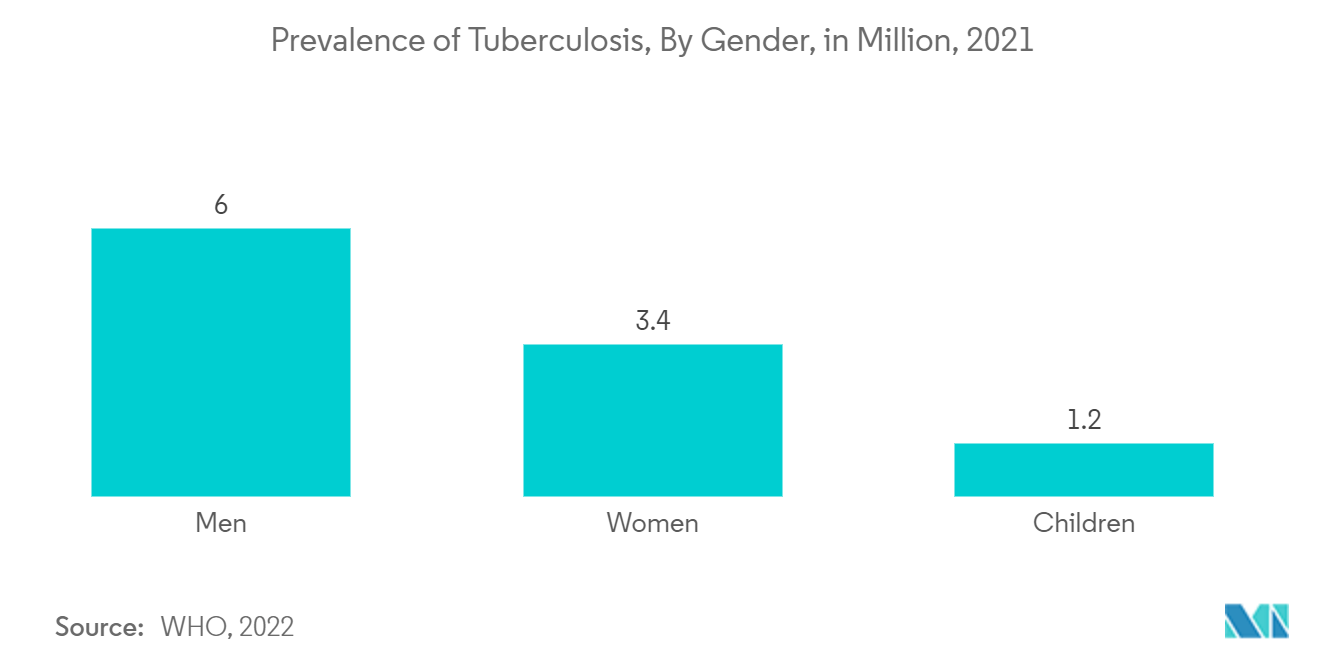
North America is Expected to Dominate the Peptide Antibiotics Market
North America is expected to dominate the market owing to factors such as the growing incidences of skin infections, and the presence of key players in the region. An increase in the number of patients suffering from hospital-acquired infections in the United States is among the key factors which contribute to the growth of the studied market in North America. According to the research article published by the American Academy of Dermatology Association in April 2022, 197,700 new cases of melanoma, 97,920 noninvasive and 99,780 invasives, will be diagnosed in the U.S. in 2022. Moreover, according to the same source nonmelanoma skin cancer (NMSC), including basal cell carcinoma (BCC) and squamous cell carcinoma (SCC), affects more than 3 million Americans a year.
New product approvals and highly developed healthcare infrastructure in the United States are some of the factors driving the growth of the peptide antibiotics market in the country. For instance, in March 2021, Melinta Therapeutics announced approval for its new-and-improved formulation of its antibiotic oritavancin in acute bacterial skin and skin structure infections (ABSSSI) caused by susceptible isolates of Gram-positive microorganisms, including Methicillin-resistant Staphylococcus aureus (MRSA). These continuous product launches and approvals in the region are anticipated to drive the growth of the market in the country.
Therefore, owing to the aforesaid factors the growth of the studied market is anticipated in the North America Region.
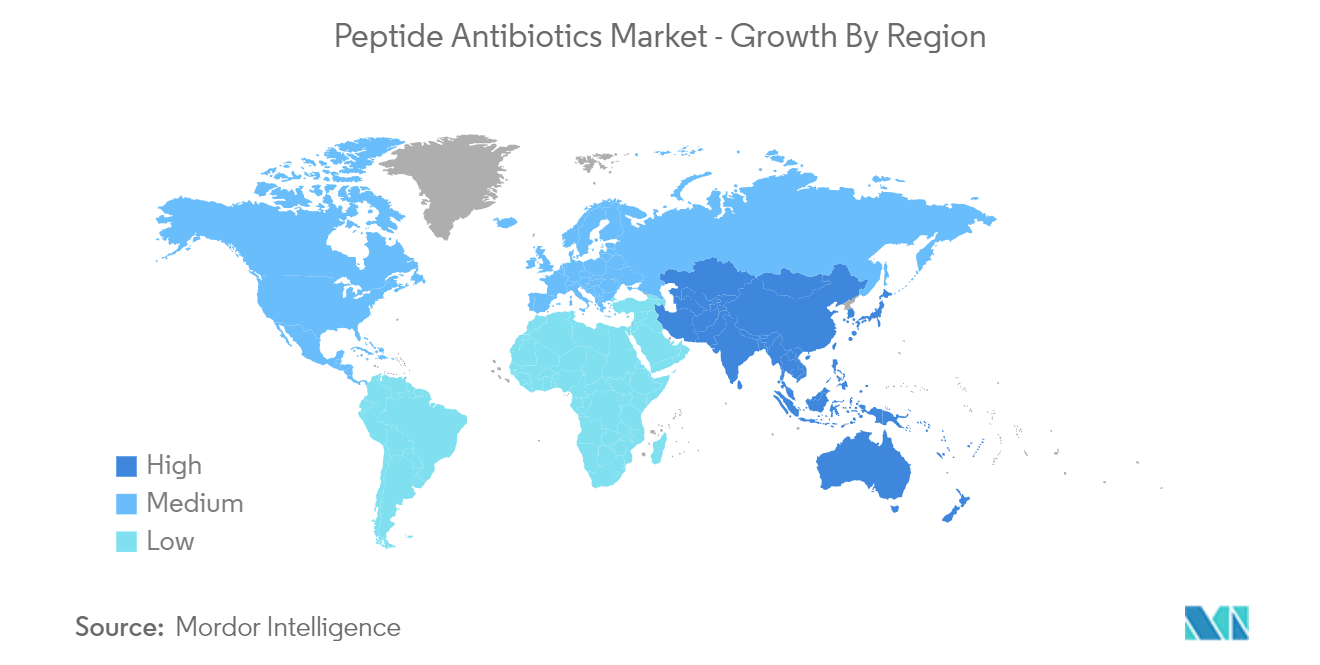
Peptide Antibiotics Industry Overview
The peptide antibiotics market is Moderately fragmented in nature due to the presence of several companies operating globally as well as regionally. The competitive landscape includes an analysis of a few international as well as local companies which hold market shares and are well known. include Merck & Co., Inc., Monarch Pharmachem, ANI Pharmaceuticals, Inc., Melinta Therapeutics, AbbVie, Cumberland Pharmaceuticals Inc., and Xellia Pharmaceuticals among others.
Peptide Antibiotics Market Leaders
-
Merck & Co., Inc.
-
ANI Pharmaceuticals, Inc.
-
Melinta Therapeutics.
-
AbbVie
-
Cumberland Pharmaceuticals Inc.
*Disclaimer: Major Players sorted in no particular order
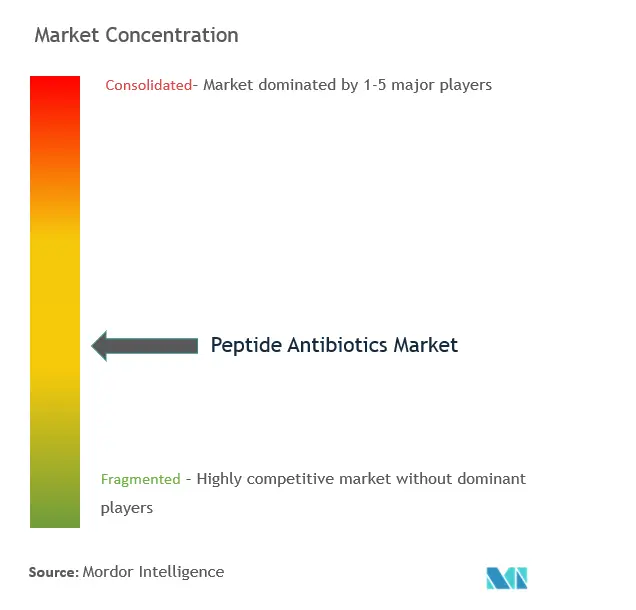
Peptide Antibiotics Market News
- In September 2022, Revance announced FDA Approval of the Peptide-Formulated product DAXXIFY (DaxibotulinumtoxinA-lanm) for Injection.
- In February 2021, CARB-X announced USD 2.65 million non-dilutive funding to Peptilogics to develop a new class of peptide antibiotics with broad activity against drug-resistant bacteria.
Peptide Antibiotics Market Report - Table of Contents
1. INTRODUCTION
- 1.1 Study Assumptions and Market Definition
- 1.2 Scope of the Study
2. RESEARCH METHODOLOGY
3. EXECUTIVE SUMMARY
4. MARKET DYNAMICS
- 4.1 Market Overview
-
4.2 Market Drivers
- 4.2.1 Increasing Prevalence of Infectious Diseases
- 4.2.2 Development of Advanced Products
- 4.2.3 Growing adoption of Peptide Antibiotics in in hospitals and clinics
-
4.3 Market Restraints
- 4.3.1 Side-effects associated with peptide antibiotics
-
4.4 Porter's Five Force Analysis
- 4.4.1 Threat of New Entrants
- 4.4.2 Bargaining Power of Buyers/Consumers
- 4.4.3 Bargaining Power of Suppliers
- 4.4.4 Threat of Substitute Products
- 4.4.5 Intensity of Competitive Rivalry
5. MARKET SEGMENTATION (Market Size by Value - USD million)
-
5.1 By Product Type
- 5.1.1 Ribosomal Synthesized Peptide Antibiotics
- 5.1.2 Non-Ribosomal Synthesized Peptide Antibiotics
-
5.2 By Disease
- 5.2.1 Skin Infection
- 5.2.2 HABP/VABP
- 5.2.3 Blood Stream Infection
- 5.2.4 Others
-
5.3 By Route of Administration
- 5.3.1 Injectable
- 5.3.2 Topical
- 5.3.3 Others
-
5.4 By Distribution Channel
- 5.4.1 Hospital Pharmacies
- 5.4.2 Retail Pharmacies
- 5.4.3 Online Pharmacies
-
5.5 Geography
- 5.5.1 North America
- 5.5.1.1 United States
- 5.5.1.2 Canada
- 5.5.1.3 Mexico
- 5.5.2 Europe
- 5.5.2.1 Germany
- 5.5.2.2 United Kingdom
- 5.5.2.3 France
- 5.5.2.4 Italy
- 5.5.2.5 Spain
- 5.5.2.6 Rest of Europe
- 5.5.3 Asia-Pacific
- 5.5.3.1 China
- 5.5.3.2 Japan
- 5.5.3.3 India
- 5.5.3.4 Australia
- 5.5.3.5 South Korea
- 5.5.3.6 Rest of Asia-Pacific
- 5.5.4 Middle East and Africa
- 5.5.4.1 GCC
- 5.5.4.2 South Africa
- 5.5.4.3 Rest of Middle East and Africa
- 5.5.5 South America
- 5.5.5.1 Brazil
- 5.5.5.2 Argentina
- 5.5.5.3 Rest of South America
6. COMPETITIVE LANDSCAPE
-
6.1 Company Profiles
- 6.1.1 Merck & Co., Inc.
- 6.1.2 Monarch Pharmachem
- 6.1.3 ANI Pharmaceuticals, Inc.
- 6.1.4 Melinta Therapeutics.
- 6.1.5 AbbVie
- 6.1.6 Cumberland Pharmaceuticals Inc.
- 6.1.7 Xellia Pharmaceuticals
- 6.1.8 JHP Pharmaceuticals, LLC
- 6.1.9 Sandoz AG
- 6.1.10 GSK plc.
- *List Not Exhaustive
7. MARKET OPPORTUNITIES AND FUTURE TRENDS
** Subject To AvailablityPeptide Antibiotics Industry Segmentation
As per the scope of the report, peptide antibiotic products are commonly used in the management of various infectious diseases. These antibiotics are less toxic and highly effective as compared to the other antibiotics. The peptide antibiotics market is segmented by Product Type (Ribosomal Synthesized Peptide Antibiotics and Non-Ribosomal Synthesized Peptide Antibiotics), Disease (Skin Infection, HABP/VABP, Blood Stream Infection, and Others), Route of Administration (Injectable, Topical, and Others), Distribution Channel (Hospital Pharmacies, Retail Pharmacies, and Online Pharmacies), and Geography (North America, Europe, Asia-Pacific, Middle East and Africa, and South America). The market report also covers the estimated market sizes and trends for 17 different countries across major regions, globally. The report offers the value (in USD million) for the above segments.
| By Product Type | Ribosomal Synthesized Peptide Antibiotics | |
| Non-Ribosomal Synthesized Peptide Antibiotics | ||
| By Disease | Skin Infection | |
| HABP/VABP | ||
| Blood Stream Infection | ||
| Others | ||
| By Route of Administration | Injectable | |
| Topical | ||
| Others | ||
| By Distribution Channel | Hospital Pharmacies | |
| Retail Pharmacies | ||
| Online Pharmacies | ||
| Geography | North America | United States |
| Canada | ||
| Mexico | ||
| Geography | Europe | Germany |
| United Kingdom | ||
| France | ||
| Italy | ||
| Spain | ||
| Rest of Europe | ||
| Geography | Asia-Pacific | China |
| Japan | ||
| India | ||
| Australia | ||
| South Korea | ||
| Rest of Asia-Pacific | ||
| Geography | Middle East and Africa | GCC |
| South Africa | ||
| Rest of Middle East and Africa | ||
| Geography | South America | Brazil |
| Argentina | ||
| Rest of South America |
Peptide Antibiotics Market Research FAQs
What is the current Peptide Antibiotics Market size?
The Peptide Antibiotics Market is projected to register a CAGR of 5.10% during the forecast period (2024-2029)
Who are the key players in Peptide Antibiotics Market?
Merck & Co., Inc., ANI Pharmaceuticals, Inc., Melinta Therapeutics. , AbbVie and Cumberland Pharmaceuticals Inc. are the major companies operating in the Peptide Antibiotics Market.
Which is the fastest growing region in Peptide Antibiotics Market?
Asia-Pacific is estimated to grow at the highest CAGR over the forecast period (2024-2029).
Which region has the biggest share in Peptide Antibiotics Market?
In 2024, the North America accounts for the largest market share in Peptide Antibiotics Market.
What years does this Peptide Antibiotics Market cover?
The report covers the Peptide Antibiotics Market historical market size for years: 2019, 2020, 2021, 2022 and 2023. The report also forecasts the Peptide Antibiotics Market size for years: 2024, 2025, 2026, 2027, 2028 and 2029.
Peptide Antibiotics Industry Report
Statistics for the 2024 Peptide Antibiotics market share, size and revenue growth rate, created by Mordor Intelligence™ Industry Reports. Peptide Antibiotics analysis includes a market forecast outlook to 2029 and historical overview. Get a sample of this industry analysis as a free report PDF download.



